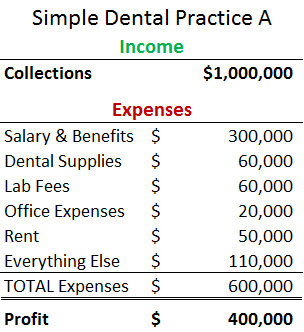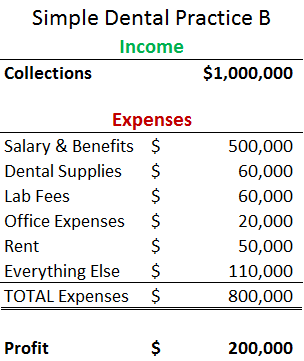Apr 7, 2016
2 Methods Every Dentist Needs to Know to Value Their Practice
Written By: Brian Hanks
Do you know the two most common ways to value a dental practice? If you’ve ever bought, or considering buying a dental practice, did you pay too much? How would you know? Does it even matter?
There is a secret to valuing your practice. Let me share what it is with a quick story.
I learned how business are REALLY valued in a finance class in my MBA program, and it wasn’t close to what I expected. At the time, I was in one of the most difficult finance classes I’d ever taken learning from the feet of one of the foremost finance professors in the world, Dr. Gautam Kaul. (In fact, if you want to take his valuation class, click here for the free online version! I warn you – it’s painful!) Week in and week out Dr. Kaul drilled us in the various methods of valuing a business – discounted cash flow, multiples method, comparable transactions, market valuation, sum of parts method, etc. We showed up each week with our models, and had them mercilessly torn apart by Professor Kaul. He had to be tough! He was training the next generation of Wall Street bankers. But, I was learning the “right” way to value a business. On the last day of class, I learned the secret of valuing a business.
“Put your textbooks away, now I’m going to share with you the secret of how this really works.” The secret, Professor Kaul told us, is that “Every valuation you do outside of class will be complete bull.” He continued, “In reality, you’re going to get hired by a client based on the fact that you’re selling them the story that you can get a buyer to pay more than any of the other brokers and bankers out there. You’re going to pick a number, and then you’re going to back into the model and assumptions that get you the number the client wanted to see in the first place. And the client will only be happy if they get that number.” He was saying that the valuation is completely made up!
Dental brokers are no different when they do valuations. If you’ve seen a valuation number for a dental practice, it is a series of assumptions piled on imperfect information. The seller hired that broker, in part, because the broker convinced them that they could get them the most for their dental practice.
So how do you know what a dental practice is really worth?
I’ll tell you the two methods that we use at PFG to see if clients are overpaying or not. We use two methods:
- Price to Gross Revenue
- Price to Earnings
I’ll explain what they mean, and how to think about them.
Price to Gross Revenue
Put succinctly, this method describes how much you need to pay for the collections of a dental practice. This is the method that most people are familiar with. It basically says, “how much will I pay for a dollar of collections?” The historical average of that number is the average buyer pays the average seller somewhere around $0.67 for $1.00 of collections. Or, if a practice collects $1,000,000, then it sells for about $670,000. (Although, when writing this in 2016, that number is a little low due to the market getting better for sellers.)
Price to Earnings
This method describes how much you need to pay for the earnings of a dental practice. It says, “how much will I pay for a dollar of earnings.” Earnings being how much the practice has left over after paying all the expenses, minus any pay and perks of the doctor. The historical average here is that buyers pay about $1.61 for $1.00 of earnings. (Again, in 2016, perhaps a little low.)
Which method is better?
The answer is “c – all of the above.” In reality, you want to know both numbers to know if you’re getting a good deal on your dental practice. Although, if I were a buyer, I would put significantly more weight on the Price to Earnings method. Let me explain what I mean with a few visual examples. Let’s say you are looking at this dental practice below.
Simple Dental Practice A is a typical practice, where I used average data and simple round numbers to show a practice that collects $1 Million, has expenses totaling $600,000 and profit left over for the doctor of $400,000. And, indeed, the average dental practice has overhead totaling about 60% of collections.
Simple Dental Practice B is exactly the same in every way, but this doctor pays her staff much better. Higher pay, maybe she pays for health insurance and a gigantic pension of some variety. There’s probably a few extra staff members around, too. (You wouldn’t want people to work too hard, right?)
Now, let’s say you’re considering buying these two practices. Which would you rather buy? And which one should be cheaper?
Easy answer, right? You’d want Practice A, because as the owner there is more profit left over for you at the end of the year.
If you’re using the Price to Gross Revenue method, both practices will be valued at the same amount by most brokers. I swear I’m not lying here, this is exactly what most brokers do. Oh sure, I just ticked off every broker I know, and their valuations always look a lot fancier with big long spreadsheets on how they arrived at their number. But, with an uncanny degree of accuracy, if I only know collections numbers, I can tell you within about 3% what any given broker valued a practice.
Given that you’re buying a business, and you’re going to live off of the profit of the business, wouldn’t you rather put more weight on the Price to Earnings method? Wouldn’t you rather buy Practice A, instead of Practice B, all other things being equal?
Of course you would.
But, here’s the rub, all other things never are equal. And every seller can give you a list of 100 reasons why you should still pay top dollar, even though they’re not as profitable as they could be.
Here’s the last thought, and (frankly) the key to this whole discussion. You don’t make most of your money buying and selling dental practices. Oh sure, you definitely don’t want to overpay when buying a dental practice. But, the real money in dentistry comes in the year-in, year-out ownership of the profit stream from the business.
If they’ve found a good practice that isn’t as profitable as it could be, I tell my clients to think about the profit stream of the business as the primary consideration. Use the Price to Earnings methodology to negotiate and bring the seller down a bit on price, if necessary. But, if you like the city the practice is in, your spouse likes the area (the most important thing we’ve talked about to this point!) the building is good, the staff seems good, the equipment isn’t junk and you think you can make it work . . . don’t get hung up on the valuation method.
Don’t overpay, but don’t make the mistake that you can mathematically figure out the value of a dental practice.
As Professor Kaul said, “It’s all bull.”

